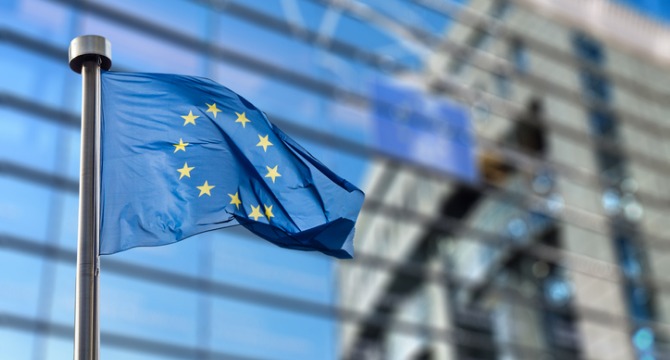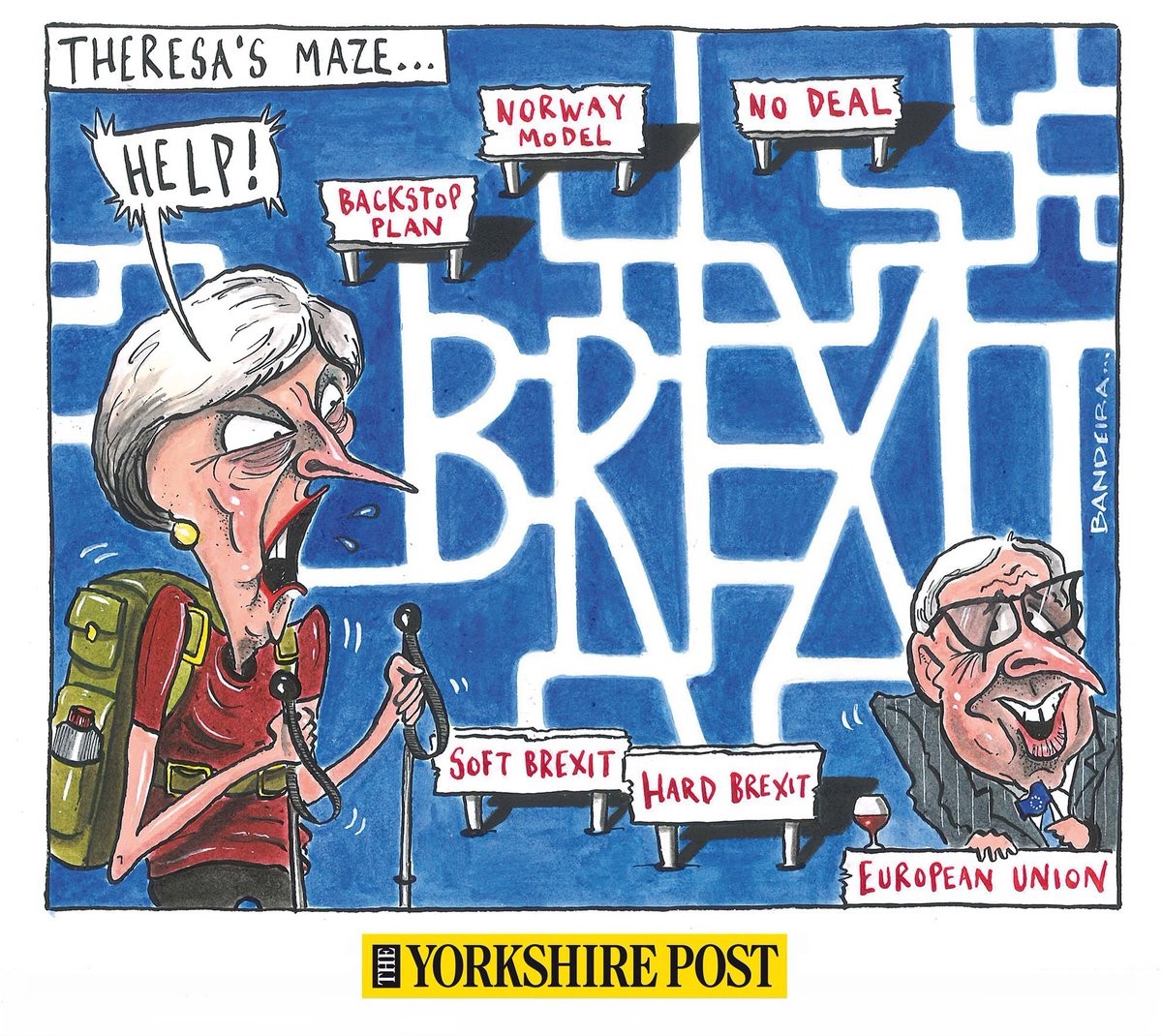
“Brexit” – the United Kingdom’s (“UK”) 2016 voter referendum to exit the European Union (“EU”) has grown from a nagging itch in many people’s sides to a full-blown feeding frenzy. There is now virtually blow-by-blow news coverage of daily developments. Pundits issue editorial warnings of dire economic consequences ahead (particularly for the UK). Savage political cartoons and even “You Tube” videos of UK and EU leaders prancing and dancing to the beat of Mama Mia are every day fodder.
Until recently UK media focus often featured the rising and falling pastry dough on “The Great British Baking Show” and the gentle, sure-handed guiding touch of show presenter, Mary Berry. Now, Mary Berry and her baking cohorts have been eclipsed in the media by the dour, dogged image of UK Prime Minister Theresa May, the public face of the Brexit drama, who is widely viewed as presiding over “The Great Brexit Breakdown.”1
The coming Brexit breakdown seems evokes a new version of the old familiar refrain “water, water everywhere and not a drop to drink.” Today, the song might go “Brexit Brexit’s everywhere and no one stops to think.” Brexit’s coming – dead ahead.
This is the seventh in an ongoing series of blog posts by Foley & Lardner LLP on the implications of Brexit.2 UK exit from the EU is currently poised to become effective on March 29, 2019.3 A tentative agreement avoiding Brexit was hammered out in late 2018 after months of the tortuous negotiations between UK and the EU27. However, UK final approval is by no means certain as bitter political infighting continues.4 The negative consequences of Brexit continue to intensify as the clock ticks toward March 2019.
Despite almost unanimous calls for resolution of the Brexit question and for urgently needed economic and regulatory clarity,5 bitter infighting in the UK among proponents of “hard,” “soft” or “no” Brexit have consumed valuable time, energy and political capital. Even in the face of this fast approaching deadline, overwhelming opposition in Parliament to the deal has caused Prime Minister May to postpone a vote on the negotiated UK/EU27 withdrawal deal until mid-January 2019.6 Perhaps, not surprisingly, calls for “no” Brexit through another voter referendum have increased.7 Support for ‘no” Brexit” has arrived from an unexpected direction – the EU’s highest court. In December 2018, the European Court of Justice (an arch-villain of “Brexiters” who have railed against UK loss of sovereignty in the EU) ruled that the UK could unilaterally withdraw its decision to exit if it chose.8 While this judicial green light has emboldened advocates a second referendum that might reverse the exit decision, time is running out and it is increasingly likely that the UK will crash hard out of the EU and face unpalatable uncertainties that are sure to weaken its economy and disadvantage its industries.
This “hard exit” out of the EU by the UK and a presumable hard landing were graphically depicted by a cartoon recently posted on Reddit.com:

Where that UK bus careening out of the EU will land is “up in the air.”
From the outset since the Brexit vote went down in 2016, it has been undisputed that the UK industry, which is economically linked to and integrated with the EU, will likely, be increasingly vulnerable after Brexit.9 Warnings of dire consequences voiced in 2016 are reiterated today – reduced competitiveness, increased costs, currency risks, inefficiency, increased unemployment, brain drain and capital flight.10 According to Carolyn Fairbairn, CBI Director-General, money has been and is flooding out of UK businesses, damaging productivity and the wider economy.”11
Sadly, the scene in the UK has not changed much since the 2017 notice to exit was issued, despite pressure of the Brexit clock. Once again in early 2019 as in 2017, the situation in the UK is aptly depicted in a 2017 cartoon appearing The Economist under the caption: “Brexit Talks – The Current State of Play.” The cartoon features a tennis court. On one side is a tall, athletic EU player serving at “advantage.” On the other (UK) side of the net, the court is further divided by yet another net running perpendicular to that net, dividing the UK side of the court into two halves. In each UK half, two clearly less-gifted UK players (labeled respectively “soft” and “hard”) are hitting errant balls at each other (instead of contesting with the EU) and shouting complaints about each other to Teresa May who is depicted sitting on the sidelines, labeling both “hard” and “soft” as at “fault.” In the background and as a reminder of the clicking Brexit two-year clock, there is the game’s umpire who seeks to have the EU and the UK sides resume playing with the not-so-gentle reminder to the UK side – “time.”

Unfortunately, despite the 24/7 news coverage, the YouTube videos and the savage cartoon caricatures, it has apparently not sunk-in on UK decision makers that Brexit is not a game of tennis played on a grass court by white-clad, upper-class gentlemen and ladies. The consequences of a no-deal hard exit are real and are fast approaching. Indeed, the horizon looks rather bleak.
Again, as has been widely recounted, the UK and the EU have been economically closely integrated for decades, particularly since the UK joined the EU in 1974. Transportation systems, communication networks, EU-wide enterprises operate within the EU system on the basis of the free movement of goods, services, capital and people. While by no means perfect, the system functioned based on EU-wide common rules and seamless borders. The overall EU economy and the UK economy, in particular, benefitted greatly from the unified system. That will change dramatically for the UK as a hard-exit will put at risk a raft of services – financial, electrical, agricultural, infrastructure funding, telecommunication – as well as the rights of EU member citizens living in the UK as well as UK citizens living in the EU. In a word, movement whether of goods, services, capital and/or people will no longer be free, easy or seamless.12
Predictions of the potential difficulties for the UK when it exits the EU are numerous and easy to find.13 For example, the CBI predicts that trade between the UK and the EU 27 will immediately face increased tariffs (+/- 5%, depending on the direction of the trade). Logistical log-jams at the ports and on the previously seamless highways (whether air, water or motorways) are widely predicted. EU financial services and the likely end of banking “passport” rights will increase costs, risks and inconvenience. Food, medicine and manufacturing inputs for UK’ previously EU-wide integrated industries will be seriously disrupted. Overall, the UK GDP is expected to fall by 5% over the near term. While the UK would seem to suffer more than the EU27, it too will feel the impact of Brexit.14
What that post-Brexit world will look like particularly for the UK remains, of course, unclear at this point.15 Assuming a hard, no-deal Brexit, it seems likely that the UK on exiting the EU may, at least in the short-term, fall back on its rights and obligations as a member of the WTO. While the WTO platform provides a general, recognizable and enforceable set of rules on issues like tariffs on goods, trade procedures, standards, etc., reliance on WTO membership will prove no easy substitute for and may well be a clear step down from the free trade benefits which the UK had enjoyed as a member of the EU. Suffice to say, it poses many complex questions that will have to be addressed.
In that event, the UK faces a daunting maze in the coming days, as the Yorkshire Post graphically depicted in a recent editorial cartoon.

Among the most cited alternatives include UK membership in the European Economic Area (“EEA”),16 the European Free Trade Association (“EFTA”)17 and a free trade customs union that the EU has with a number of countries.18 However, all of these alternatives have major negatives for the UK. All of these alternatives substitute membership in a seamless EU market for other interests – greater sovereignty and enhanced control over immigration. However, they all come at a potentially significant price that must be weighed against the value of the perceived Brexit rationale and Brexit’s justification. Indeed, in balancing such competing interests, some might even consider membership in the EEA, EFTA or a free trade customs union with the EU to represent a significant step backwards for the UK and for the EU as well.
Whatever the outcome, the UK will likely require a long time to recover from the serious, negative ramification flowing from Brexit. There’s water, water everywhere but not a drop to drink. There’s Brexit, Brexit everywhere but it’s time people stop and think.
——————————————–
1 See Gerard Baker, “The Great Brexit Breakdown,” Wall Street Journal (December 8-9, 2018).
2 Prior Foley Brexit blogs have reviewed: 1) developments leading up to the Brexit vote, likely competition law as well as procedural implications; 2) risks/uncertainties for standardization and innovation; 3) possible legal alternative outcomes posed by Brexit – a hard landing, a soft landing or never-never land; 4) wheeling and dealing to shore up political and economic support; and 5) the commencement of the formal divorce proceedings and 6) the intense infighting among conservatives about the Brexit decision, process and outcome. Links to the prior six Brexit articles posted on the Foley & Lardner Automotive Blog are as follows:
https://www.autoindustrylawblog.com/2016/07/18/brexit-what-when-and-why/
https://www.foley.com/brexit–standards-and-innovation-what’s-ahead-08-15-2016/
https://www.foley.com/brexit-hard-landingsoft-landing-or-down-the-rabbit-hole-whats-ahead-10-17-2016/
https://www.foley.com/brexit-whats-ahead-let-the-games-begin-11-14-16
https://www.autoindustrylawblog.com/2017/03/30/brexit-ukeu-jump-into-the-unknown-whats-ahead/#more-2943
https://www.autoindustrylawblog.com/2017/11/13/brexit-the-natives-are-restless-and-seem-desirous-of-fighting/
3 As has been clear throughout this Brexit push toward exit, deadlines, however fixed in law or stone, sometimes are at the last moment flexible as the process plays out in real time and real life.
4 “EU say no to May on renegotiating deal,” BBC.com (December 14, 2018). Perhaps, a “nip or a tuck” here or there, but the EU has no stomach for further accommodations to the UK.
5 John Allen, President of the Confederation of British Industry (“CBI”), said in an address to his CBI colleagues that a no-deal Brexit would be “a nightmare scenario … which would be a wrecking ball for our economy.” CNBC, (November 18, 2018).
6 Ironically, the most vocal opponents of the deal are hard-core Brexiters who are members of May’s own Conservative party.
7 See “A Second Brexit Referendum was once a pipe dream. Now some wonder if it’s the only way out of the chaos.” The Washington Post (December 15, 2018).
8 A group of Scottish pro-Europe petitioners (including the “Good Law Project”) had brought an action to seek a ruling whether the UK could change its mind about Brexit. The Scottish Court of Sessions ruled that it could on September 17, 2018. On a referral to the European Court of Justice (“ECJ”) to determine whether, under EU law, the UK could unilaterally halt the Brexit process, the ECJ ruled on December 10, 2018 that the UK could revoke its withdrawal from the EU as long as the withdrawal agreement between the UK and the EU had not been formally executed and the two-year Article 50 notice period had not run. EU Court Press Service (December 10, 2018).
9 Of course, these industry concerns are not new. See “Toyota Demands Clarity over Brexit,” The New York Times (October 25, 2017); “Tied to Europe, British Car Industry is Vulnerable after Brexit,” The New York Times (December 6, 2016).
10 In 2016, one senior union spokesperson stated about the future prospects of his plant after Brexit, “it is absolutely suicidal.” See The New York Times (Ibid at 2).
11 CNBC report on November 19, 2018.
12 As is well understood, there are, however, a significant number of EU-generated rules and regulations that have been adopted by the UK and will remain in place. Still, there will be substantial uncertainty. Moreover, the UK borders with the EU have never been totally seamless as the UK never was a party to the 1995 Schengen agreement.
13 There have been many studies starting even before the 2016 UK referendum. See, e.g., The Institute for Government “Understanding the Economic Impact of Brexit” (October 19, 2018); OECD, “The Economic Consequences of Brexit: A Taxing Decision” (April 2016); Financial Times, “What are the Economic Consequences of Brexit So Far?” (June 23, 2018).
14 See “Free falling,” The Economist (November 24, 2018). This article on a no-deal Brexit provides a comprehensive look into the rabbit hole as the UK is pushed ever closer to jumping into the oblivion.
15 See, “May’s Brexit Deal is Likely to Fail. What Happens Then?” New York Times (December 11, 2018)
16 Lord David Owen most recently urged serious consideration of this idea in an op-ed piece in the November 2, 2018 Sunday Times of London. His article is entitled “If May loses in the Commons, we have one card left: the EEA.” Current members of the EEA are Norway, Iceland and Lichtenstein. As has been underscored before, however, UK membership in the EEA does little to achieve the goals of Brexit (assuming current EEA members would approve). The EEA requires that EEA members observe all of those EU four freedoms (including free movement of people), make financial contribution to the EU budget and compliance with many EU rules and regulations.
17 Switzerland is an EFTA member. However, EFTA members do not have the same seamless free trade in services that the UK enjoys today within the EU which could prove a major negative for the UK banking industry. EFTA members are, as well, subject to the jurisdiction of the EFTA court would conflict with the clear goal of Brexit supporters who sought to avoid surrendering UK sovereignty to the European Court of Justice.
18 The EU has free trade customs union agreements with, for example, Morocco, Tunisia, Israel, Turkey, etc. However, such an agreement may complicate trade agreements with other trading partners.
